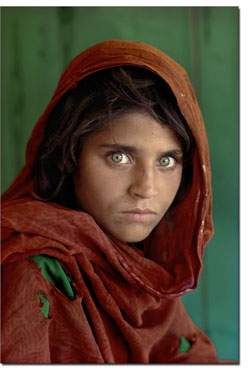|
| ||||
| The unguarded moment
by Jules Masterjohn For some, wanderlust is an acquired state. For others, it is hardwired into their psyche. Photographer Steve McCurry has been a globetrotter since his late teens, curious about other cultures and documenting them for nearly 40 years. During his travels, he has snapped some of the world’s most unforgettable photographs. Many of these images have been published in National Geographic, Life and other prominent magazines, and for these photographs McCurry has earned some of his profession’s highest honors. On display at Open Shutter Gallery in Durango is “The Unguarded Moment,” 35 photographs by McCurry that chronicle everyday life and people from some of his favorite countries in the eastern hemisphere. All are stunning compositions that inform about cultures far from our own and many, especially his portraits, offer a glimpse into our shared humanity. McCurry’s ability to click the shutter at the precise moment when the boundaries between the photographer and the subject dissolve is what makes his portraits so powerful. Perhaps without intending it, he takes an empathetic point of view with his lens, allowing the subject to be vulnerable. He wrote in his website, “If you wait, people will forget your camera and the soul will drift up into view.” His most renowned image, “Afghan Girl,” is among the photographs on display at the gallery. By now, most have heard the story of this famous picture: the anonymous girl was photographed while living in an Afghani refuge camp in Pakistan in 1984. Through the young girl’s wide-eyed fear, the photograph brought home the searing truth of the affects of war on civilians and the plight of Afghani refugees. In 2002, McCurry wanted to reconnect with the once-young-girl-now-woman. After a long search, he found Sharbat Gula living in Pakistan, now married and a mother of three. Their reunion made headlines as well as another portrait, and McCurry has set up a fund to enabled Gula to educate her children and fulfill her dream of taking a pilgrimage to Mecca. Other portraits by McCurry possess a similar power to bring the subject and the viewer face-to-face and heart-to-heart. “Smoking Coal Miner,” Puli Khumri, Afghanistan, 2002, is a riveting representation of a hard-earned life. The sitter’s piercing stare tells almost all, leaving the viewer to wonder what those eyes have seen. McCurry’s composition is simple and solid, like the rock this miner works daily.
Many arresting and interesting images from Sri Lanka, India, Afghanistan, Tibet and Africa are shown in “The Unguarded Moment.” The same intimacy found in his portraits is present in his street scenes. Like Henri Cartier-Bresson, one of his inspirations and mentors, encounters in daily life intrigue him. And like his elder, McCurry is interested in what is happening “beneath the surface” of these seemingly mundane activities frozen in the camera’s moment. Hardly a visitor or mere traveler to many countries on the globe, McCurry has been to Afghanistan almost 40 times and has made more than 80 trips to India. It was in India a few years after he graduated college, that he acquired his taste for sustained travel. Intending to stay for just six week, shortly after his arrival he contracted amoebic dysentery and was bitten by a rabid dog for which he underwent injections to his stomach. Two years later, McCurry was still on the Indian subcontinent and had become familiar with much of it as well as Nepal, Pakistan and Thailand. When people ask him about how to become a photographer, he tells them to “first leave home. Go as far as you can. Become a stranger in a strange land. Acquire humility. Leaving home really means that the photographer (or writer) has to wander, observe and … concentrate on people in their landscape. That is what I try to achieve in my pictures.” One photograph, “Women at the Shoe Stall,” Kabul, Afghanistan, 1992, does just this by portraying the complexity of a world in which traditionalism and modernity are simultaneously valued. Five burka-wearing women are huddled together looking into a shoe vendor’s stall, their backs to the photographer. Above their heads hang numerous pairs of high-tech running shoes for sale. Picturing the lives and customs of different cultures in a visually poetic way is one aspect to McCurry’s work. Another is his use of a vivid yet nuanced range of color, which he owes to his use of Kodachrome film. Unfortunately, Kodachrome was discontinued this summer, and McCurry has moved onto other film stocks and sometimes shoots digitally. His images, regardless of the technology used, continue to embody the unique presence of the people and places he visits. “We go to another culture to observe how other people live. Sometimes you look at somebody on the street and they just seem to have a strong presence, a look, a certain kind of attribute that comes out in the face,” McCurry offered in an interview for Focus magazine. “As human beings, we are all fascinated with each other and how we look.” • “Steve McCurry: ” is on display through Oct. 1 at Open Shutter Gallery, 735 Main Ave. Gallery Hours are Tues.-Sat. 10 a.m.-9 p.m., Sun. & Mon., 10 a.m.-6 p.m. Limited edition posters signed by McCurry, are also available as are many books of McCurry’s work.
|
In this week's issue...
- May 15, 2025
- End of the trail
Despite tariff pause, Colorado bike company can’t hang on through supply chain chaos
- May 8, 2025
- Shared pain
Dismal trend highlights need to cut usage in Upper Basin, too
- April 24, 2025
- A tale of two bills
Nuclear gets all the hype, but optimizing infrastructure will have bigger impact



